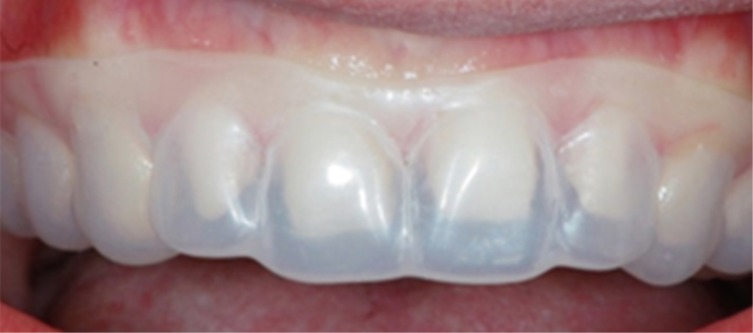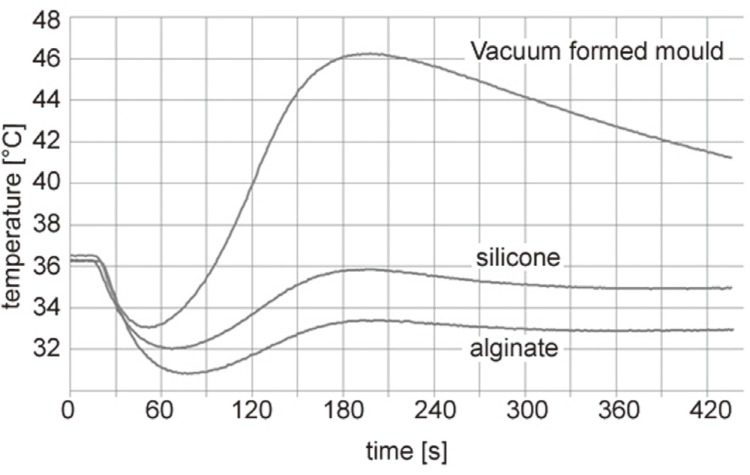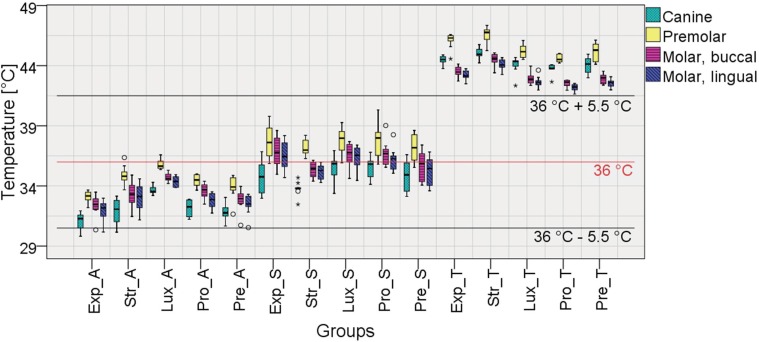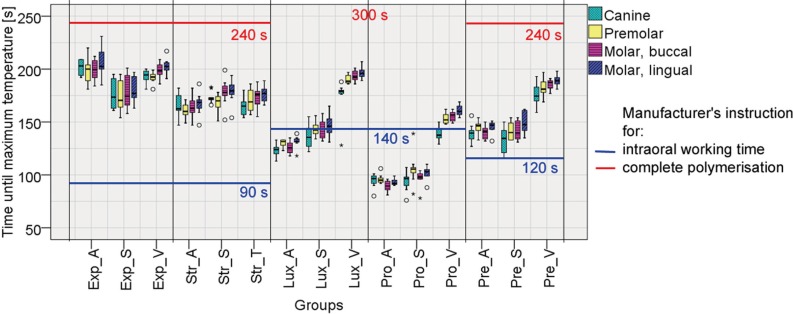J Adv Prosthodont.
2017 Aug;9(4):294-301. 10.4047/jap.2017.9.4.294.
Influence of the material for preformed moulds on the polymerization temperature of resin materials for temporary FPDs
- Affiliations
-
- 1Department of Prosthetic Dentistry and Biomedical Materials Research, Hannover Medical School, Hannover, Germany. Pott.Philipp-Cornelius@mh-hannover.de
- KMID: 2398077
- DOI: http://doi.org/10.4047/jap.2017.9.4.294
Abstract
- PURPOSE
Temperature increase of 5.5 ℃ can cause damage or necrosis of the pulp. Increasing temperature can be caused not only by mechanical factors, e.g. grinding, but also by exothermic polymerization reactions of resin materials. The aim of this study was to evaluate influences of the form material on the intrapulpal temperature during the polymerization of different self-curing resin materials for temporary restorations.
MATERIALS AND METHODS
30 provisonal bridges were made of 5 resin materials: Prevision Temp (Pre), Protemp 4 (Pro), Luxatemp Star (Lux), Structure 3 (Str) and an experimental material (Exp). Moulds made of alginate (A) and of silicone (S) and vacuum formed moulds (V) were used to build 10 bridges each on a special experimental setup. The intrapulpal temperatures of three abutment teeth (a canine, a premolar, and a molar,) were measured during the polymerization every second under isothermal conditions. Comparisons of the maximum temperature (T(Max)) and the time until the maximum temperature (t(TMax)) were performed using ANOVA and Tukey Test.
RESULTS
Using alginate as the mould material resulted in a cooling effect for every resin material. Using the vacuum formed mould, T(Max) increased significantly compared to alginate (P<.001) and silicone (P<.001). In groups Lux, Pro, and Pre, t(TMax) increased when the vacuum formed moulds were used. In groups Exp and Str, there was no influence of the mould material on t(TMax).
CONCLUSION
All of the mould materials are suitable for clinical use if the intraoral application time does not exceed the manufacturer's instructions for the resin materials.
Keyword
MeSH Terms
Figure
Reference
-
1. Kim SH, Watts DC. Exotherm behavior of the polymer-based provisional crown and fixed partial denture materials. Dent Mater. 2004; 20:383–387. PMID: 15019454.
Article2. Barlattani A, Cardelli P, Cioccolanti F, Gallio M. Polymerization exothermal reaction of dental prosthetic resin for temporary crowns. A comparative evaluation. Minerva Stomatol. 2002; 51:11–20. PMID: 11845116.3. Zach l, Cohen G. Pulp response to externally applied heat. Oral Surg Oral Med Oral Pathol. 1965; 19:515–530. PMID: 14263662.
Article4. Baldissara P, Catapano S, Scotti R. Clinical and histological evaluation of thermal injury thresholds in human teeth: a preliminary study. J Oral Rehabil. 1997; 24:791–801. PMID: 9426160.
Article5. Amano T, Muramatsu T, Amemiya K, Kubo K, Shimono M. Responses of rat pulp cells to heat stress in vitro. J Dent Res. 2006; 85:432–435. PMID: 16632756.
Article6. Kwon SJ, Park YJ, Jun SH, Ahn JS, Lee IB, Cho BH, Son HH, Seo DG. Thermal irritation of teeth during dental treatment procedures. Restor Dent Endod. 2013; 38:105–112. PMID: 24010075.
Article7. Castelnuovo J, Tjan AH. Temperature rise in pulpal chamber during fabrication of provisional resinous crowns. J Prosthet Dent. 1997; 78:441–446. PMID: 9399184.
Article8. Chiodera G, Gastaldi G, Millar BJ. Temperature change in pulp cavity in vitro during the polymerization of provisional resins. Dent Mater. 2009; 25:321–325. PMID: 18817967.
Article9. Lenz E, Lang V. Comparative study on the biological properties of plastics for temporary crowns and bridges. Stomatol DDR. 1990; 40:100–102. PMID: 2284649.10. Firoozmand L, Faria R, Araujo MA, di Nicoló R, Huthala MF. Temperature rise in cavities prepared by high and low torque handpieces and Er:YAG laser. Br Dent J. 2008; 205:E1. discussion 28-9. PMID: 18535534.
Article11. Srimaneepong V, Palamara JE, Wilson PR. Pulpal space pressure and temperature changes from Nd:YAG laser irradiation of dentin. J Dent. 2002; 30:291–296. PMID: 12554109.
Article12. Bevilacqua L, Biasotto M, Cadenaro M, Di Lenarda R, Dorigo E. Reaction exothermia of 2 relining resins for temporary crowns. Minerva Stomatol. 2005; 54:35–41. PMID: 15902061.13. Piplani A, Suresh Sajjan MC, Ramaraju AV, Tanwani T, Sushma G, Ganathipathi G, Jagdish K, Agrawal A. An in-vitro study to compare the temperature rise in the pulp chamber by direct method using three different provisional restorative materials. J Indian Prosthodont Soc. 2016; 16:36–41. PMID: 27134426.
Article14. Seelbach P, Finger WJ, Ferger P, Balkenhol M. Temperature rise on dentin caused by temporary crown and fixed partial denture materials: influencing factors. J Dent. 2010; 38:964–973. PMID: 20728504.
Article15. Kulkarni MM, Thombare RU. Dimensional changes of alginate dental impression materials-An invitro study. J Clin Diagn Res. 2015; 9:ZC98–ZC102.
Article16. Al-Zarea BK, Sughaireen MG. Comparative analysis of dimensional precision of different silicone impression materials. J Contemp Dent Pract. 2011; 12:208–215. PMID: 22186818.
Article17. Moulding MB, Teplitsky PE. Intrapulpal temperature during direct fabrication of provisional restorations. Int J Prosthodont. 1990; 3:299–304. PMID: 2083018.
- Full Text Links
- Actions
-
Cited
- CITED
-
- Close
- Share
- Similar articles
-
- Polymerization shrinkage, hygroscopic expansion and microleakage of resin-based temporary filling materials
- In vitro study of tooth temperature change during polymerization reaction of the cold-cured resins used in provisional crown and fixed partial dentures
- EFFECT OF TIME AND TEMPERATURE ON THE MARGINAL FIT OF PROVISIONAL RESIN CROWN DURING POLYMERIZATION
- Effects of immediate and delayed light activation on the polymerization shrinkage-strain of dual-cure resin cements
- Evaluation of polymerization ability of resin-based materials used for teeth splinting







